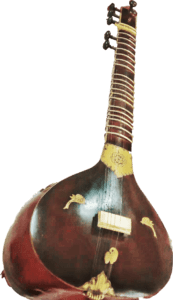Sitar was initially used as a supporting instrument in qawali and ghazal. As the name implies, the first sitar had three strings. One steel string and the remaining two bass strings were used. The steel string was set to madhyam, while the later one was tuned to Sadaj and Pancham. The sitar has between 14 and 17 frets. Even though there were numerous modifications made to the sitar’s basic structure, the mentioned structure was maintained for a very long time. The changes occurred in the number of strings, and likewise on frets at different times. Contextually speaking, it is important to note that making a sitar is a highly skilled and specialized art that calls for a thorough knowledge of the materials and procedures used. The process of making a sitar can take several months and involves many different steps, including:
Selection of Materials: The first step in making a sitar is selecting the appropriate materials. The sitar’s body is typically made of seasoned teak wood, while the soundboard is made of cedar or spruce. The frets are made of brass or steel, and the strings are traditionally made of gut or silk.
Carving the Body: Once the materials have been selected, the body of the sitar is carved to the desired shape. This involves using chisels and other specialized tools to create the complex curves and contours of the instrument.
Fitting the Soundboard: The soundboard is then fitted to the body of the sitar. This involves carefully shaping the soundboard to match the contours of the body and then securing it in place with glue and clamps.
Adding the Frets: The frets are then added to the neck of the sitar. This involves cutting small grooves into the neck and inserting the frets into these grooves. The frets must be placed very precisely in order to ensure accurate intonation.
Adding the Strings: The strings are then added to the sitar. This involves tying the strings to the bridge and winding them around the tuning pegs. The strings must be tuned very carefully in order to ensure proper intonation and sound quality.
Decoration: Finally, the sitar is decorated with various ornamental elements, such as inlaid designs, carving, or painting.
The tradition of Sitar making in India dates back several centuries and has been passed down through generations of craftsmen. The art of making sitars requires a great deal of skill, knowledge, and experience, and it has traditionally been learned through an apprenticeship system. In the past, sitar makers were often associated with a particular court or patron. Their craft was supported by wealthy patrons who appreciated fine music and the art of instrument making. Over time, the craft of Sitar making became more widespread, and many workshops were established in different parts of the country. The techniques and materials used in sitar making have evolved over time, and different regions and communities in India have developed their unique styles and approaches to the craft. The sitar makers of Kolkata are known for their attention to detail and the use of high-quality materials, while the Sitar makers of Miraj are known for their innovative designs and use of technology. Today, Sitar making in India is still largely a handmade process, with skilled craftsmen using traditional techniques to make each instrument. Many of these craftsmen have been making sitars for decades and have deep knowledge and understanding of the instrument’s construction and sound. Despite the challenges posed by modern manufacturing techniques and global competition, the tradition of Sitar making in India continues to thrive. The country’s rich musical heritage and the dedication of its craftsmen ensure that this beautiful instrument will continue to be made with care and skill for generations to come.
The role of makers in the Sitar is essential in the production and development of the instrument. Sitar makers are highly skilled artisans who are responsible for constructing the instrument from raw materials and ensuring that it meets the requirements of the musicians who will be playing it.Sitar makers play a crucial role in the development and evolution of the instrument, as they are responsible for creating new designs and techniques that can improve the sound and playability of the Sitar. They work closely with musicians to understand their needs and preferences, and they use their expertise to create instruments that meet those needs. In addition to constructing the sitar itself, makers are responsible for selecting and sourcing high-quality materials for the instrument. This can include selecting the appropriate type of wood for the neck and body, choosing the right type of strings and frets, and selecting high-quality hardware such as tuning pegs and bridges. Another important role of Sitar makers is to provide maintenance and repair services for the instrument. This can involve replacing strings and frets, adjusting the bridge and nut, and fixing any other issues that may arise over time. Through craftsmanship and expertise, sitar makers contribute to the ongoing development and refinement of the instrument, allowing musicians to create new and innovative music for generations to come. The process of making a sitar requires a high degree of skill and attention to detail. A well-made sitar can produce a rich and complex sound that is essential to the performance of Indian classical music. The process of making and maintaining the instrument is changing with the advancement of technology. However, the process is a tradition and continues with the traditional values.
2.3 Types of Sitar
The following are a few significant changes that gave the instrument’s core framework a new look. Although the modifications stated below are not chronological, it is crucial to note that they are nonetheless significant.
Single Sitar (Without Taraf)

I recall my father giving me a Sitar when I was a little child. Although having a similar fundamental structure to what I had seen on television or in images, it was not as complex as a sitar should be. My father clarified the distinction for me. Almost everyone in their early sitar learning days has played the sitar, often known as a single sitar or a sitar without taraf. Although the sitar is frequently played, we rarely witness this in public performances. In this case, clarification is necessary.
Nevertheless, I quickly realize how much I needed the other Sitar as I continue to play the Sitar. Before the taraf strings came to use, there were sitars without sympathetic strings (Taraf). According to what Kaushik Banerjee wrote with reference to the image of Nihal Sen holding a sitar with taraf pegs, it was probably not until the early 19th century that taraf strings were added to the Sitar (Banerjee, 2017). The single Sitars continue to be used alongside the main Sitars till date. Since tuning multiple sympathetic strings requires skills, the sitar is still in use, especially for beginners and young musicians. Dand (the wooden board on which the frets are connected) is thinner than usual.
Moreover, compared to the sitar, the frets are smaller. It is easier for kids to handle because it is somewhat lighter than other Sitars. The melodic prowess of the Sitar is less developed. The Sitar is only used to teach students the basics of music; it is not seen in concerts. The Sitar’s use is ebbing over time.
Sitar with Taraf

All sitars following the first one are tarafdar Sitars. According to their tuning and other structural architectonics, tarafdar Sitars are divided into two styles: Kharaj and Gandhar Pancham. It’s not just the different structures of Sitar; it’s the world where Sitar revolves. The reader can understand what I’ve said as we move forward in writing. Technically speaking, in the Kharaj Pancham tuning, the strings are tuned in a pattern that creates a drone and sympathetic resonance with the main strings.
Kharaj refers to the low-pitched sound produced by the main playing strings of the sitar. The Kharaj strings are typically the thickest and produce a rich, deep sound that is fundamental to the sitar’s unique timbre. In Indian classical music, the Kharaj is an important element of a raga (melodic framework). The use of the Kharaj strings in different ways, such as sliding or bending the notes, can create expressive nuances and add depth to a performance. The Kharaj also provides a drone that supports the melody and helps to create the distinctive sound of Indian classical music. The playing methods for the sitar are based on the dhrupad singing methods. The dhrupad alap, which is sung at a lower pitch, is properly complemented by the Kharaj String. The Kharaj Pancham Sitar is played by Sitar players of all Gharana except the Etawa/ Imdadkhani Gharana. Having said that, it is important to mention that every Gharana has its unique features added and excluded from the basic structure of the Kharaj Pancham Sitar. Thus, it would be excessively technical and unjust to limit the various sitar playing techniques to the term “Kharaj Pancham”. Each unique component in each Gharana carries the philosophy and aesthetics of the originator and followers.









